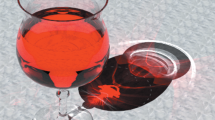Abstract
Caustic effects produced by the transport of light from specular surfaces to diffuse surfaces are a common type of optical effect that cannot be modeled by ray tracing. We propose a two-pass algorithm to model caustic effects efficiently and reliably. In the proposed method, information on transmitted light beams is collected in a tree structure, which is used to compute the intensity efficiently. The method does not require the polygonization of diffuse surfaces and can easily be combined with any rendering algorithm.
Similar content being viewed by others
References
Appel A (1968) Some techniques for shading machine renderings of solids. Proceedings of American Federation of Information Processing Societies (AFIPS) JSCC, pp 37–45
Arvo J (1986) Backward ray tracing. SIGGRAPH Course Notes, No. 12
Arvo J, Kirk D (1987) Fast ray tracing by ray classification. Comput Graph 21:55–64
Campbell AT, Fussell DS (1990) Adaptive mesh generation for global diffuse illumination. Comput Graph 24:155–164
Chen SE, Rushmeier HE, Miller G, Turner D (1991) A progressive multi-pass method for global illumination. Comput Graph 25:165–174
Glassner AS (1984) Space subdivision for fast ray tracing. IEEE Comput Graph Appl 4:15–22
Hanrahan P (1983) Ray tracing algebraic surfaces. Comput Graph 17:83–90
Heckbert PS, Hanrahan P (1984) Beam tracing polygonal objects. Comput Graph 18:119–127
Kajiya JT (1983) Ray tracing parametric patches. Comput Graph 16:245–254
Kajiya JT (1983) New techniques for ray tracing procedurally defined objects. Comput Graph 17:91–102
Mitchell D, Hanrahan P (1992) Illumination from curved reflectors. Computer Graph 26:283–291
Shinya M, Takahashi T, Naito S (1987) Principles and applications of pencil tracing. Comput Graph 21:45–54
Sillion F, Puech C (1989) A general two-pass method intergrating specular and diffuse reflection. Comput Graph 23:335–344
Snyder JM, Barr AH (1987) Ray tracing complex models containing surface tessellations. Comput Graph 21:119–128
Toussaint G (1985) Computational Geometry. North-Hollard, Amsterdam
Wallace JR, Cohen MF, Greenberg DP (1987) A two-pass solution to the rendering equation: a synthesis of ray tracing and radiosity methods. Comput Graph 21:311–320
Watt M (1990) Light-water interaction using backward beam tracing. Comput Graph 24:377–385
Watt A, Watt M (1992) Advanced Animation and Rendering Techniques, Theory and Practice. Addison-Wesley, Wokingham UK
Author information
Authors and Affiliations
Rights and permissions
About this article
Cite this article
Chuang, JH., Cheng, SA. Computing caustic effects by backward beam tracing. The Visual Computer 11, 156–166 (1995). https://doi.org/10.1007/BF01898601
Issue Date:
DOI: https://doi.org/10.1007/BF01898601




